This is Rhodesia
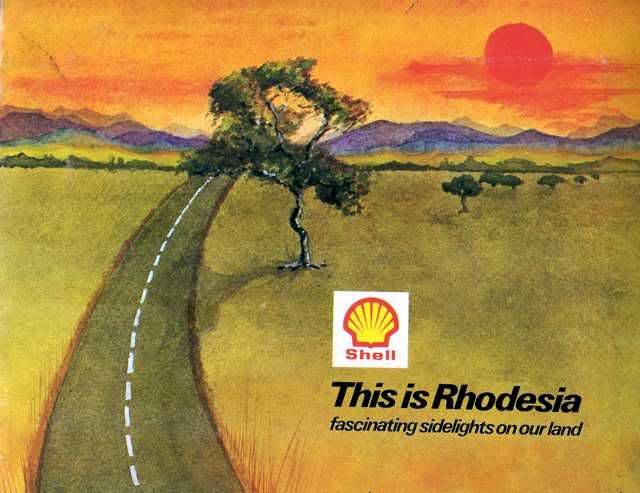

THE basic facts of Rhodesia, past and present, are well known. Our history is well recorded; statistics of commerce and industry, population, climate and geography are all freely available.
However it is the lesser known stories of life—the joys and sorrows of people, their struggles and unrecorded achievements—that go together to form that patchwork which, in time, becomes the fabric of a nation's tradition.
Our aim here is simply to throw a little light across the shade in an informal, pleasant and memorable way. We sincerely hope you will enjoy this collection.
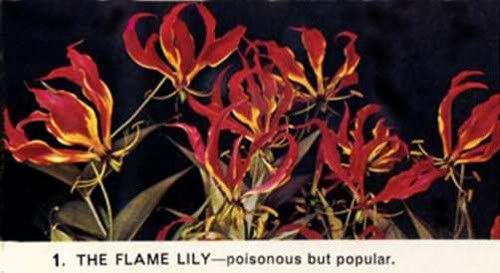
Gloriosa superba is tho Latin name. Glorious and proud is the flower. It is Rhodesia's national emblem, the flame lily, found in varying colours in virtually every corner of the country.
Red. yellow, orange or purple, the flame lily grows from a tuber. Lying dormant all winter, it begins to sprout in October, and by Christmas is generally in full and beautiful bloom. Although tho plant itself is poisonous, it is very much sought after as it grows well in gardens, and makes an ideal filler for odd spots in a rockery.

Gloriosa superba is tho Latin name. Glorious and proud is the flower. It is Rhodesia's national emblem, the flame lily, found in varying colours in virtually every corner of the country.
Red. yellow, orange or purple, the flame lily grows from a tuber. Lying dormant all winter, it begins to sprout in October, and by Christmas is generally in full and beautiful bloom. Although tho plant itself is poisonous, it is very much sought after as it grows well in gardens, and makes an ideal filler for odd spots in a rockery.
When the Queen of England, as Princess Elizabeth, visited Rhodesia in 1947. she was given a diamond brooch in the form of a flame lily as a twenty-first birthday present by tho children of this country. The jewel obviously appealed to her more than most, for she wore it on many public occasions on her return to England. In fact she chose it for her first public engagement after her marriage. Her favour further endeared the flower to tho people of Rhodesia and from that time on it has gone from strength to strength. In its unchallenged position today it is the equivalent of the English rose, the Welsh daffodil and the Dutch tulip.
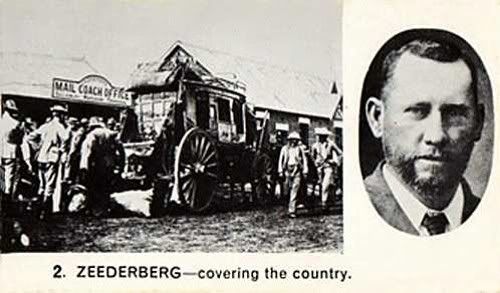
ON a bright spring morning in 1927 the people of Umtali heard the piercing note of the post horn for the last time. Four coaches, each drawn by twelve sleek mules, bumped and rattled out of town en route to Bulawayo. They were making Zeederberg's last run after more than thirty years of service in rain and shine throughout Rhodesia
In 1890 Cecil Rhodes commissioned Doel Zeederberg to survey the country and suggest likely road links. Tho work took him three years of hard riding and walking from Fort Tuli and the Limpopo to Fort Victoria. Salisbury and Broken Hill. In 1895 he carried his first passengers and mail from Pietersburg to Salisbury. Soon afterwards the Zeederberg network was complete, with links between all the main towns.
Coaches were imported from Ohio. USA. at a cost of R $700 each. They carried twelve passengers, with room on top for luggage. Mules generally provided the power, but Zeederberg once used a span of trotting oxen. When mules were very scarce he even tried to train zebras, but they proved too slow and lazy.
Motor transport and the railways finally ended the days of coaching, but they had already done sterling service. Rhodes himself said that no other individual had done more to open up Rhodesia than Doel Zeederberg.
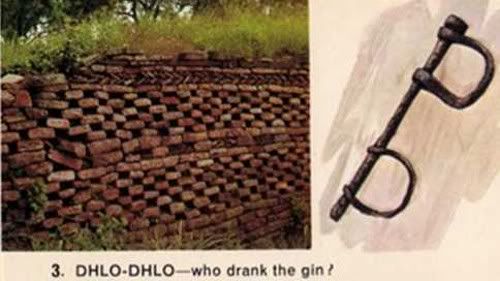
A 270-year-old gin bottle, a Chinese bowl and a pair of Arab handcuffs. Prize finds from Dhlo-Dhlo, one of the many ruins of ancient stone buildings throughout Rhodesia, but finds that simply add to the the mystery of the country's past.
Who drank the gin. or perhaps more important, who brought it to Dhlo-Dhlo? All that is known is that the bottle is Dutch and that it dates to around A D 1700 The blue and white Chinese bowl is thought to be from the Ming dynasty, and the handcuffs are definitely of the kind used by Arab slavers. Other interesting finds include a candlestick, two Portuguese cannon and a handful of religious relics.
Dhlo-Dhlo lies a few kilometres from Fort Rixon. and is one of the more interesting ruins. It features five different types of wall decoration. including the famous Zimbabwe chevron pattern.
Some experts believe it may have been the centre of a sun worship cult. They feel certain too. that observations of the sun and stars were taken there.
The building is thought to date from the second Zimbabwe period, but no one knows for sure. The ruins themselves have provided a mixed bag of clues
Perhaps more wait to be uncovered.
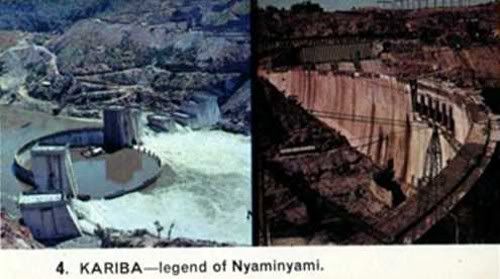
ON A calm day Kariba presents a warm and comfortable sight Houses nestle against the hillsides. The lake stretches for miles, still as a millpond. There is little to suggest tho turbulent and sometimes tragic past that made Kariba a much feared name to the people who lived in the valley before the gorge was plugged with concrete.
Perhaps the great river god 'Nyaminyami' has given up his age-old battle against mankind.
Where the mighty Zambezi squeezed through the narrow gap at Kariba. the resulting fearsome turbulence had carried many a man to his death. It was probably this danger that gave rise to the legend of Nyaminyami. At any rate, the locals believed the god existed, and they predicted a diro fate for anyone who attempted to meddle with his domain. They viewed plans to build a wall there as a most provocative piece of interference.
Subsequent deaths by landslide, flood and construction accident confirmed their belief. Nyaminyami' was fighting back
But in the end. the work was completed. Only occasionally now. when a sudden squall from the west whips up huge waves on the lake and boating becomes dangerous, do tribesmen still tremble for fear of Nyaminyami!
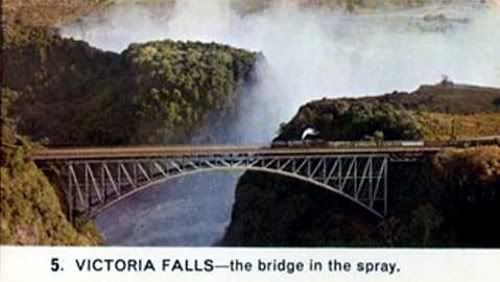
Although he did not live to see the bridge, its location was due entirely to his sense of the aesthetic. Cautious engineers had recommended a far easier site six miles above the falls, but Rhodes would have none of it. Instead he insisted that the bridge cross the gorge at a point where train passengers could feel the spray.
His romantic notion greatly taxed the skill of designer and engineer, but the bridge slowly began to take shape. Work was always extremely dangerous because of the 350-ft. sheer drop, but thanks to meticulous safety measures, accidents were kept to an absolute minimum. During the entire operation only one worker was killed.
The final girder was swung into position and tightly bolted down at 6 a m. on April 1st. 1905. A great man's dream of a graceful railway bridge had become reality.
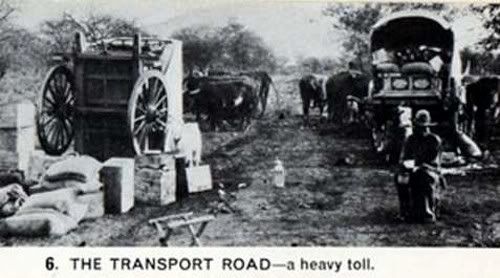
"The Road". as tho old riders know it. took a heavy toll in patience, sanity and even life.
One of the riders who wrote most about his life in Rhodesia was Stanley Portal Hyatt. On page after page his books reflect a hard and relatively unrewarding career During the rainy season, progress could more often be measured in inches per day than miles per hour It was nothing to bo held up at a swollen river for six weeks at a time. Lion, hyena, jackal and snakes were a constant menace to his cattle. And in the end, the rinderpest put him out of business.
"The cattle died within a few hours." he wrote "And then the transport rider, utterly broken, utterly helpless. abandoned all and tramped back to the nearest outspan., to curse his luck, to drink so as to forget that luck, and. perhaps, to die."
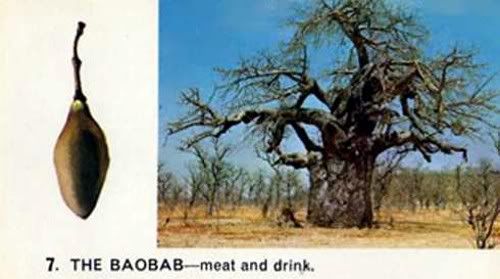
ACCORDING to African legend the baobab owes its grotesque beauty to an angry god who wrenched it from the ground and in his fury replanted it upside down. Thus its branches are what were once its roots. Certainly that is what it looks like, but grotesque or not. it is one of the most useful trees in the Rhodesian bush
One way or another, the baobab is capable of providing man with shelter, food, water, cloth and even liquor.
The interior, saturated with water, is more pulp than wood, and experienced bush men know well how to tap the precious fluid in times of emergency. The fruit is a source of cream of tartar, and was at one time used as the chief ingredient in a brew against malaria.
The fruit provides an emergency food for man, fodder for cattle and a source of fibre for weaving coarse cloth. The pollen yields a glue, and the flowers can be distilled into a liquor.
Among the more famous of these giants is on tho border where Rhodesia meets the Caprivi Strip. Standing behind a neat little house, the tree has been carved and hollowed out to form a room
Inside is the toilet, complete with water flush!
Though the baobab is found in other African countries, and even in Australia, its great abundance in Rhodesia gives it an undoubtedly special relationship with our land.
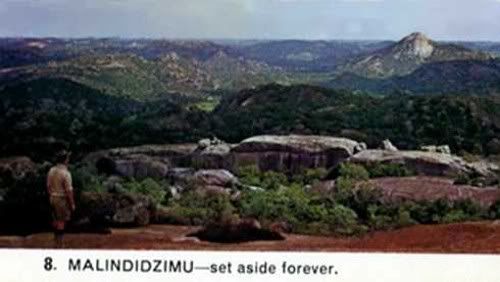
THE View of the World was always a sacred spot. Even before the time of tho Matabele, this granite hill in the Matopos was known to tho Karanga people as Malindidzimu. 'the Holes of the Spirits'. The Matabele kept the name and revered the hill. Rhodes saw it and is buried there—as are 36 other Rhodesians who have "deserved well of their country".
The words themselves belong to Rhodes. In his will he asked that "no person be buried there unless the Government says that he or she has deserved well of tho country".
Close by the path that leads to his grave, at the foot of the last rise, is a tablet, carved from solid granite. It records the simple message:
"This ground is consecrated and set aside for ever."
Also at Rhodes's request. the 34 men of Allen Wilson's patrol who were killed at the battle of the Shangani in 1893. are buried there.
Leander Starr Jameson, early Administrator, and Sir Charles Coghlan. first Prime Minister of Southern Rhodesia, have their last resting place at World's View.
The honour has been sparingly given so that this lovely hill will truly be much venerated for generations to come.
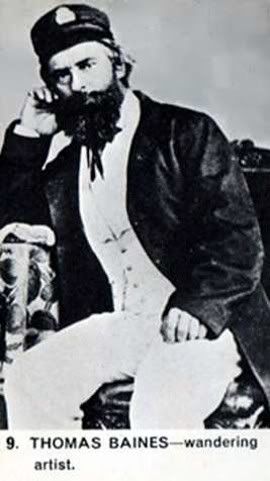
NEARLY a hundred years after his death his work is still well known and highly valued. And although he was not. in the strictest sense of the word, a Rhodesia he was an early visitor here. becoming a groat favourite of the then heir to the Matabeleland crown, Lobengula.
Thomas Baines was born at King's Lynn. England, in 1820 As a young boy he was apprenticed to a commercial artist, and at the age of 22 sailed for the Cape.
There he began work as a professional painter, but did not stay long. After many travels, including a voyage to Australia, he returned to Africa and led an expedition to Matabeleland and Mashonaland in search of gold.
It was a time of political instability, for Mzilikazi was dead and Lobengula had not yet been proclaimed king. He quickly became friendly with Lobengula who was fascinated to watch him at work. In his Northern Goldfields Diaries. Baines records: "I cultivated his friendship through the medium of art."
Everywhere he went his paintings acted as his passport and his purse. Africans were intrigued by his colourful sketches of their daily life, and lonely traders often engaged him to decorate their homes or restore the sign-writing to their wagons.
He died of dysentery in Durban on May 8th. 1875, leaving behind a vivid record of the Africa he had known.
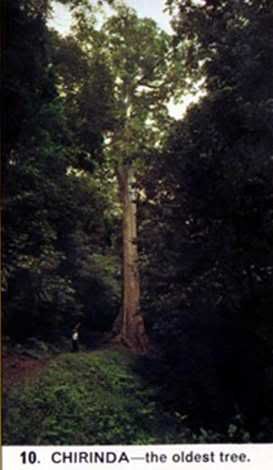
ON a far-off corner of Chipinga, on Mount Selinda. close to the Portuguese border, is a magnificent Red Mahogany that may have been a sapling when Caesar ruled the world. Nearly seventy metres tall with a handsome fifteen metre girth at its base, the tree still flowers every year and scatters its winged seeds to the corners of Chirinda Forest.
Tho 500 hectare forest and the mighty tree have been declared National Monuments so that all Rhodesians may enjoy their splendour for many generations to come.
Each November, its small, delicate white flowers open to the sun. The fruit swells slowly until the following summer a pod bursts and sends forth seed.
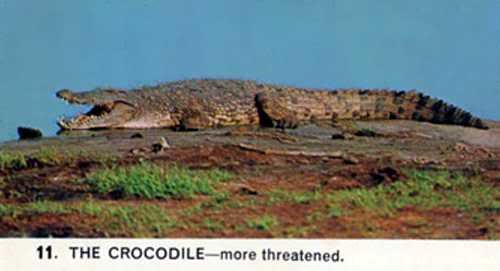
T0 ANY but tho most dedicated naturalist, the crocodile is a loathsome creature. With sixty savage teeth in a savage looking head, the reptile's appearance alone is enough to strike fear. Add the ability to move silently and invisibly through murky water. and you have a perfect recipe for total enmity.
The fact is that until recently, the crocodile had very much more to fear from man than vice versa, 1n Rhodesian waters.
Crocodylus niloticus was a most successful species until man brought his sophisticated weaponry to bear. Fashion placed a value on tho crocodile's skin, and that was almost enough to guarantee extinction. Hunters wrought havoc among the once large riverbank populations. sometimes killing nearly a hundred in a single night.
Worried naturalists, convinced that the reptile was a vital part in the balance of river life, finally won a protracted battle to bring an end to the systematic slaughter. Now indiscriminate shooting is prohibited. The hunter's rifle and shooting lamp have given way to progressive husbandry And crocodile farmers themselves protect tho future of the species by returning a certain number of young to the rivers of Rhodesia each year.
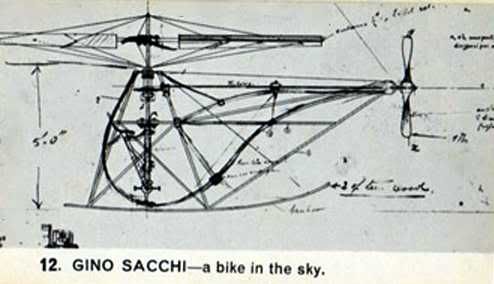
A PRIZE of thousands of dollars awaits the first person to fly a man-powered machine over a half a mile. figure-of-eight course. Many have tried, few have even got off the ground. A Rhodesian almost accomplished the feat way back in 1921. but there was no prize then, nor was he after money. He simply wanted to survey his farm from the air.
Gino Sacchi came to the country in 1917 and settled at Makwiro, 80 kilometres from Salisbury No ordinary immigrant, he had lived with fame at his fingertips as draughtsman for Bleriot. first man to fly the English Channel.
In 1921 Sacchi designed and built a 'sky-bike', in which he planned to fly around the farm. It was made from bamboo, canvas, steel wire and aluminium at a cost of under $30.00. The pilot sat facing the rear, providing power by pedal, chain and aluminium shaft
At the very first attempt Sacchi actually got the craft aloft and kept it there for several moments. Exhausted, he next asked his faithful servant Masumo to make an attempt. Frantically though he pedalled Masumo only succeeded in crashing headlong into the bush.
There is no record of any further attempt, but Sacchi must still rank almost certainly as the first airman to get off the ground in a man-powered machine. Unfortunately the record cannot be officially claimed because there were no official witnesses!
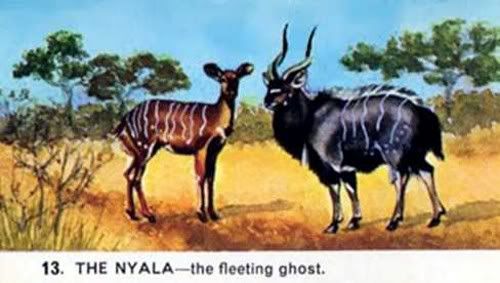
Tragelaphus angasi is a shy and unforgiving animal. Long experience of the hunter's rifle has taught the Nyala to seek almost permanent refuge in the gloomy depths of riverine forests. Only very occasionally does the "fleeting ghost" emerge at late evening to feed in some open glade. Human eyes seldom light upon its great beauty.
Thus has been born tho belief that the Nyala is facing extinction in Rhodesia. In fact they are nowhere near so, and though few people ever see them, experts report that they have adapted well to living in relative proximity to humans.
The Nyala, like the Kudu, wears distinctive white stripes along its body and a strong white chevron upon its face. It is greyish brown, with a ridge of long white hairs on its back. The long hairs on its neck form a clear mane. Beautiful white spots decorate its flanks and the male Nyala sports a handsome set of curving horns.
Shy as they are. tho Nyala can bo dangerous when cornered or wounded, but far prefers flight to fight. The privileged few who have seen them speak of their extraordinary beauty, and it seems a great pity that the Nyala has found it necessary to treat us with invisibility.
Perhaps, now that he has been protected, 'the fleeting ghost' will gradually emerge from the forests to show himself off to our admiring visitors.
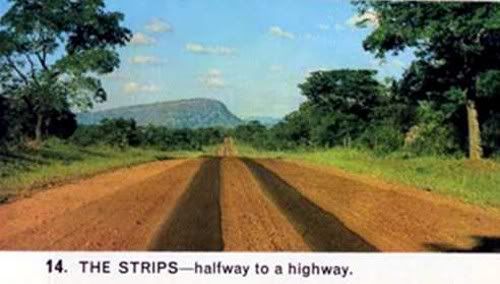
THE cost of making today's modern super highways run into many, many thousands of dollars per kilometre Forty years ago a scheme for surfacing Rhodesian roads was abandoned because it was too highly priced at $800 per mile!
It was the year 1930, and with the rapid advance of the motor car. something had to be done about the rutted, corrugated and dusty roads. As an experiment, two parallel strips of concrete were laid on the road between Gwelo and Selukwe.
"Too expensive", said the pundits as they looked at the $800 per mile bill. Thus the experiment ended for the moment, but it did give birth to the unique strip system that ultimately served the country so well.
The breakthrough came with asphalt. Strips could now be made for $200 loss per mile, and tho saving tipped the scales in favour of a major, countrywide building programme. By the middle of World War II. when tho programme ended, many hundreds of miles of rough dirt road had been converted into what, for the time, were highly acceptable highways.
On January 23rd. 1970. a short stretch of strips near Melfort was declared a national monument so that future visitors might be guaranteed a close-up view of an otherwise vanishing Rhodesian curiosity.
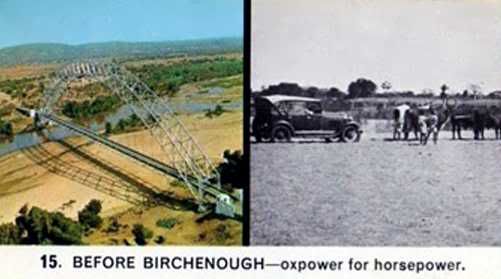
IT IS now nearly 40 years since Birchenough Bridge was opened across tho Sabi River. Before 1934, motor travellers between Fort Victoria and Umtali were faced with a most unusual crossing. Whether they liked the idea or not. they had briefly to exchange their modern horsepower for the power of the humble ox.
Two spans of oxen were stationed at the crossing, a point not far from the bridge site, and on each side of the river a plough disc 'simbi' hung in the shade of a big tree. On arrival, the motorist would summon a team by beating loudly on the makeshift gong. If he was too early the team would not yet have been rounded up. Too late and the oxen would already have been kraaled for the night.
In daylight hours however, a team would appear, fully inspanned and complete with 'tow rope*.
The haul across the river could be made only in the dry season when the actual course was confined to a narrow and shallow channel in the sandy bed. For anyone foolish or unlucky enough to attempt the trip when the Sabi was in flood, the prospect was simply a long, long wait. At such times the oxen enjoyed a well deserved rest!
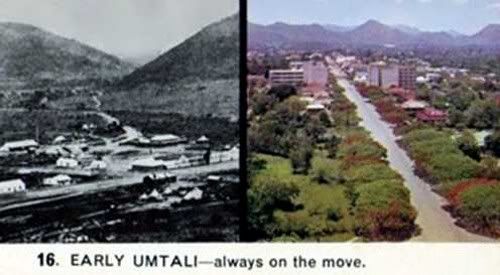
THOUGH other Rhodesian towns have changed position, none has shifted ground quite as much as Umtali. In the first ten years of its life, first gold, then the attraction of transport, prompted one move after another.
The first place to bear the name was little more than a camp on a rise in the Penhalonga valley. Here a contingent of pioneers and police pitched their tents and built a small fort in November 1890. Less than a year later the site had to be abandoned because enthusiastic prospectors had pegged the entire area, including the fort ! New Umtali came into being some miles away on the Umtali river, and with 300 stands actually surveyed, government buildings and a police camp erected, the stage seemed set for a stable future. By 1896 the population was close to 100. and everyone was looking forward to the arrival of the railway line from Beira. when the real boom would surely begin.
Too bad! Engineers decided the hills were too steep to get the line to Umtali. so they would have to bypass it. Cecil Rhodes stepped in. If the line couldn't get to Umtali. could not Umtali get to the line ?
Against some opposition and with the aid of fair compensation, the majority agreed to move. By September 1897, Umtali had finally come to rest. The beauty of the site never fails to impress the visitor today, and he must surely wonder why it wasn't first choice anyway.
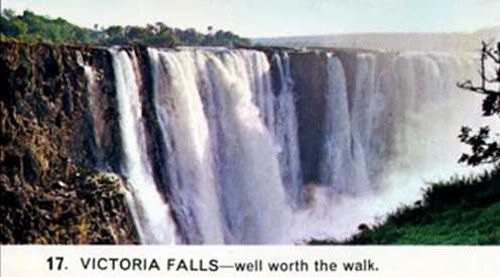
THE Victoria Falls defy adequate description. Words alone can never capture their great beauty and almost frightening power. Every man must see them for himself.
The trip is well worth the effort, as Major Henry Stabb found in 1875 when he walked all the way from Bulawayo! He was not the first to visit tho Falls, but he certainly was among the initial handful of 'tourists', and he left a vivid account of his journey.
Major Stabb was stationed with tho British army at Queenstown in South Africa when he decided to go to the Zambezi. Travelling to Lobengula's capital at Bulawayo by ox wagon, he had to continue into the tsetse fly country on foot. The march took nearly a month. He suffered terrible boils and blistered feet, at times he was without food or water, yet when he reached the Falls he was overwhelmed by what he saw.
"They are wonderful, beautiful and grand beyond description." he wrote in his diary that night. "The impression left by the magnificence of the panorama can never be effaced. Once beheld it must forever be a cause of wonder, even to the least impressionable man..."
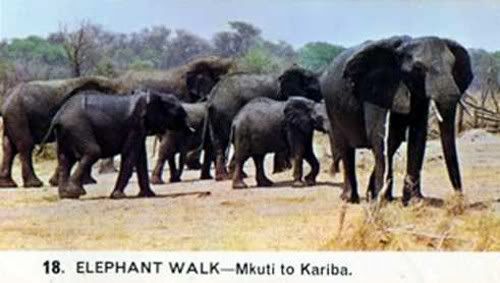
PEOPLE who have visited Kariba fairly regularly over the past fifteen years often comment how much they miss those tell-tale signs that once marked the road from Mkuti. Buffalo Nek', Puff Adder Ridge'. Savory's Folly'; names to capture the excitement of Rhodesia in the days when the mighty dam was being built.
There was a certain panache about the way things were done then. The road to the gorge had to be completed in six months before the heavy rains of 1955 brought everything to a standstill.
With the route not yet even surveyed, experts judged the target impossible Not so the Irrigation Department's Mr. J. Savory. A part-time hunter. Savory knew of an elephant path from the main road to the vicinity of the gorge, and he also knew that where the heavy elephant trod, man could confidently follow.
And so the Department's young engineers worked in the footprints of the herds, marking their progress with the memory of various incidents: here someone stood on a puff adder, there they had a brush with truculent buffalo. And at Savory's Folly' the work almost came to a standstill in a difficult two-mile patch
Now the road is tarred and the signs are gone, but the memory remains—and the elephant still walk that way.
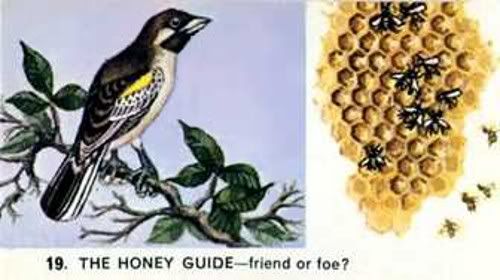
HE'S just a tiny little chap. Scientists call him Indicator indicator. In the late African afternoon you may meet him as you stroll through the bush.
"Cher... Cher. Che. cher..." he shouts at you and flaps his wings noisily as he darts about to attract your attention. Watch him. Follow him. for he will lead you to a bee hive. And if you should rob it, take care to leave a little honey for your guide. If you fail him, it is just possible ho will take a nasty revenge—or so African legend has it.
Tales of the Honey Guide's achievements abound in this country. Most of them have the usual happy ending in a honey comb, but some are more sinister. There have been persistent claims, for example, that the bird lures strangers to an angry lion's den or into the path of a charging elephant.
The evidence is purely circumstantial, and ornithologists agree that while Indicator indicator may occasionally have slipped up and led the unsuspecting to a nasty end. his motives are strictly honest. Its honey he's after, and without you or a friendly badger, he can't get it!
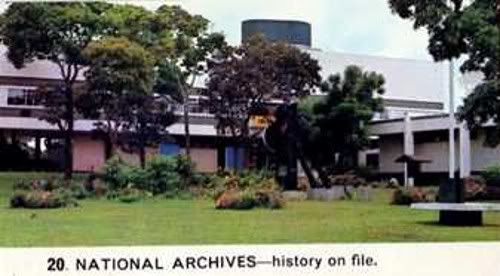
AS YOU flash by the National Archives on the Borrowdale road a few miles from Salisbury, the sharp white walls and a black funnel-like structure give the appearance of a mighty ocean liner tied fast to the quayside. Within, however, the busy men and women padding along the silent corridors are accommodating history instead of passengers.
Want to know who named Mount Hampden? What route Father Silbeira followed to Angola in the sixteenth century?
The answers are close to hand at the Archives. Newspapers, pamphlets. letters, books, paintings company records—whatever is produced in Rhodesia or about Rhodesia each day finds its way here, where the country's history is on file.
Early records of Rhodesia were kept by the BSA Company, but only those that were thought worthwhile at the time. Some were sent to London, others destroyed. Then in 1935 the Archives Act was promulgated. A call went to London for the return of documents held there, but war intervened, and many were destroyed by German bombs in an air-raid.
The Archives soon outgrew its first tiny offices. The present building was commissioned in 1961, and now houses a truly fantastic collection from which the researcher can gleam detailed information on almost any aspect of Rhodesian life and history.

THERE is nothing quite like the Rhodesian State Lottery In thirty-seven years it has become firmly established as part of the Rhodesian way of life
Millions of dollars have been paid out in prizes; millions have gone to charities and other public orientated projects. And although the sweep is now held every month, the excitement of a big draw never fades.
Jackie Keller. Trade Unionist and MP. had to fight hard to have the lottery officially recognised. The idea first came up in 1929. when the railwaymen he represented were particularly hard hit by the depressions In an attempt to raise funds for the most needy cases, he ran the 'Unity Stakes'. This unofficial lottery was a groat success, benefiting many charities and individuals at a time when there was very little public money for relief work. But the law was unimpressed, and Keller was taken to court and fined $100.
Refusing to give up. he took the matter to Parliament, determined that the lottery should be put on an official, state basis. Clearly he had captured the public imagination, so in 1934 a referendum was held and Keller's lottery lobby won by the handsome margin of 16 946 votes to 3 604
The official wheels of fortune had their first spin on December 20th. 1935
To view a lottery ticket please visit the link below:-
http://rhodesianheritage.blogspot.com/2010/10/rhodesian-state-lottery-ticket.html
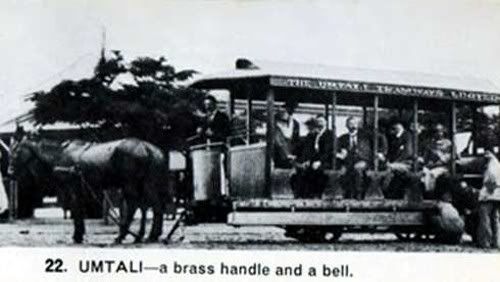
UNTIL quite recently a corner of Umtali's Main Street was scarred in the centre where two old rail lines showed through the tarmac—relics of the town's long-forgotten tramcar public transport. As the only centre in Rhodesia to have boasted a tram service. Umtali has little to regret and much fun to look back on.
Old timers still smile at the recollection of tho creaky old carriages battling up Main Street behind a span of oxen or mules
The Tramway Company was actually registered in 1897. but it was not until 1901 that the first passenger took his maiden trip at the princely sum of five cents a mile. The service was not a groat commercial success, and the advent of the motor car spelled eventual disaster Its total life span was under 20 years, but death came slowly, provoked by constant complaints from motorists that the Main Street lines interfered with their slender tyres.
Towards the end the service was being run only once a month, and each occasion was celebrated afterwards with a splendid party
Now. a few wheels, a brass handle and a bell lie stranded for our inquisitive eyes upon a shelf in the Umtali Museum; tho last lonely reminders of the city's brief flirtation with the tram.
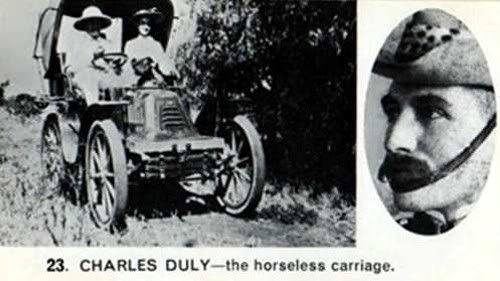
ALTHOUGH his name was later to become associated with another, far more famous make of automobile, Charles Duly chose a French 6½ horsepower 'Gladiator' as the first car to be brought into Rhodesia. The year was 1902; the city Bulawayo.
Doubtless many Rhodesians had seen motor cars in their travels elsewhere, but the arrival of the Gladator caused something of a stir in Bulawayo. There is no record of Mr. Duly having to copy the English practice of having a man walking in front of his machine with a red flag, but the wonder and apprehension which the motor car caused are nevertheless quite clear. Assigned to report on the wonderful machine, a Bulawayo journalist recorded in obvious awe that the chain-driven, single cylinder contraption was powered by "a spirit called petrol". It was steered, he added, by a "wheel which enabled the driver to change direction at any speed". thus avoiding tho stones and tree stumps which were the main feature of Rhodesian roads.
Whatever the reception, the car had come to stay. However. Charles Duly made his mark on the country for more than importing the first car. During the First World War he organized and commanded Rhodesia's first military motorised transport division, which saw service in Tanganyika. For his part. Duly received a special letter of commendation from Winston Churchill.
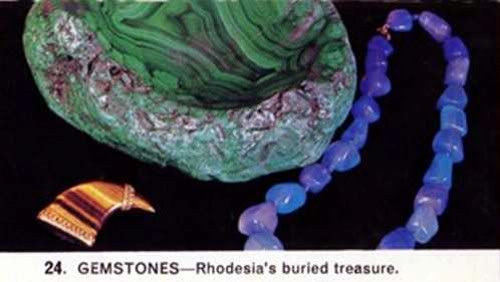
SPODUMENE. hiddenite. carnelian and jade. Spinel, chalcedony, zircon and epidote .. . gemstones of Rhodesia's wonderful natural collection. With close to a hundred different types—from diamonds to common quartz—Rhodesia is certainly gemstone country.
Despite the comparative abundance, the collection of gemstones in this country was left to only a few enthusiastic collectors until relatively recently. Now their ranks have swelled considerably, and backroom workshops where stones are cut and polished have turned a hobby into an industry,
The stones owe their value to their hardness, rarity and beauty—a quality that may involve colour, lustre, clarity or sparkle Finding the stones is. of course, not easy, but there are places in the country where geologists say finds are most likely. Karoi and Unrungwo produce sodalite. cordierite. beryl, topaz and tourmaline. The area around Fort Victoria yields beryl, chrysoberyl and spodumene. Superb emeralds come from Belingwe, and diamonds have been found in different parts of the country.
Aside from the truly precious stones, such as diamonds and emeralds. collectors often cut, polish and tumble their own specimens, exporting the best examples. Better stones like the Belingwe emeralds are used in the most exquisite jewellery.
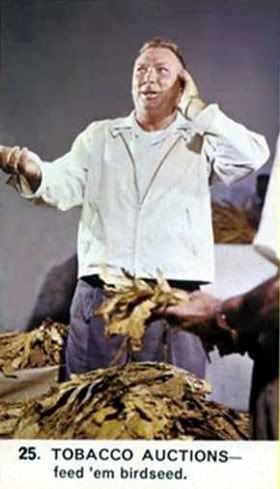
SINCE 1966. tobacco auctions have been held each year behind closed doors. Gone, for the time being at least, is their glory and glamour as one of Rhodesia's major tourist attractions. After many, many years in the public limeligh. it seems incredible that Salisbury children now growing up have never heard the magic of tho auctioneer's chant.
Visually, the sales might have been confusing to the newcomer. Hundreds of bales of tobacco were set out in long rows across the vast floor. Little knots of people could be seen dotted about, touching, feeling, smelling tobacco from the opened bales Somewhere among the rows a buying team would be moving at a steady clip from bale to bale, apparently to the accompaniment of an unintelligible song.
"And a hibbedy hibbedy hub. and a hibbedy ha. and a ha. and a ha. and a ha ha ha ..the auctioneer seemed to sing, while the buyers behind him would lift a finger, touch an ear or nod to signify their acceptance of the escalating price.
Once, when a royal visitor expressed surprise that the human throat could utter such a sound, the Chairman of Tobacco Auctions, who was acting as her escort. whispered: "We make 'em sing to save their voices. Ma'am. That's why we have to feed 'em on bird seed!"
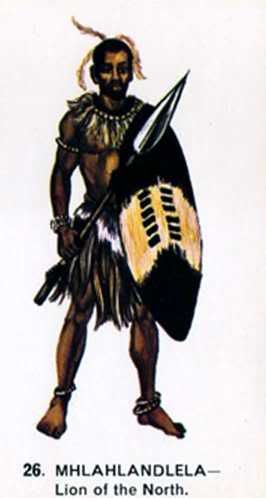
SIXTEEN miles from Bulawayo on the Old Gwanda road the traveller will come upon a great Imgugutu tree. In its shade by the road-side stands a huge slab of granite surrounded by a low and attractive stone wall. Today it is just a monument, a spot on the veld. Busy, exciting Mhlahlandlela has gone for ever: gone with the death of the king who made it.
Mhlahlandlela. Capital, for the last years of his reign, of Mzilikazi. founder of the Matabele nation
When he died. Mhlahlandlela went into mourning and ultimately ceased to exist, for Lobengula moved the capital to Bulawayo.
His fathers' monument was erected in 1941 by the Bulawayo Rotary Club—paid for entirely by European subscription.
The inscription reads simply:
''Mzilikazi. son of Shobana. the Matabele hail you. The Mountain fell down on September 9th, 1868. All nations acclaim the son of Shobana. Bayete!"
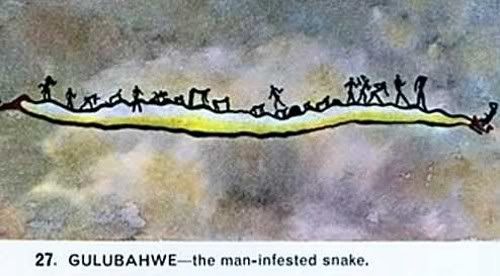
TWELVE miles beyond the Matopos Mission on the Old Gwanda Road is a wonderful cave of ancient human habitation. A preserved National Monument, Gulubahwe is nearly ten metres wide at the mouth and five metres from the floor to roof. It contains some of the best preserved and most unusual rock paintings in Rhodesia.
Chief among the paintings is one that has puzzled many archaeologists. It stretches for half the length of the cave and is a fabulous monster of primitive imagination. The five-metre long snake has awesome teeth, ears and a curly tail. From its nostrils appears a faint suggestion of smoke.
Unlike many rock paintings it is extremely colourful. The head and tail are in red. the body a faded white. The underside is yellow, outlined in purple.
Strangest of all the monster's features are twenty-four undulations along its back. On these are depicted fourteen human figures, seven baboons, three buck, and a baboon with the head of a buck.
Gulubahwe was discovered by Europeans in 1904. African porters with the party announced that they knew the beast well. Yes. they said, it was a snake. But it was a snake made of hills and rivers, and men lived upon its back.
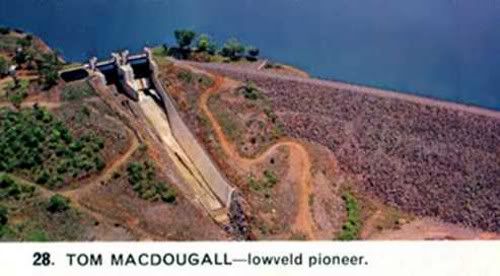
GIVEN water, man can make the desert bloom. Without it, the richest soil is wasted, as was the case for many years with Rhodesia's fertile southern lowveld. The vast agricultural development that has taken place there in the past fifteen years stems largely from the efforts of one man. Tom Macdougall brought water to his fields in 1931 and proved that the lowveld could flourish.
Macdougall first saw the area in 1912, but it was only after the First World War that he bought land there and began ranching cattle on Triangle Estate. A serious slump in 1922 turned his thoughts to diversification, and having worked on a sugar estate in British Guiana, it was natural he should think of this crop. But he needed water, and a range of granite hills stood between his fields and the nearest reliable source, the Mtilikwe river. The obstacle was difficult, but not impossible, so for the next seven years, working when funds permitted. Macdougall blasted a tunnel through nearly 500 metres of solid granite. Finally tho work was complete. Water flowed to his lands and the sugar cane grew well. A new industry was born.
Today the tunnel and his first canals are overgrown. More modern waterworks have replaced them. But Lake Macdougall in the lowveld commemorates the powerful contribution of a very dogged Scot!
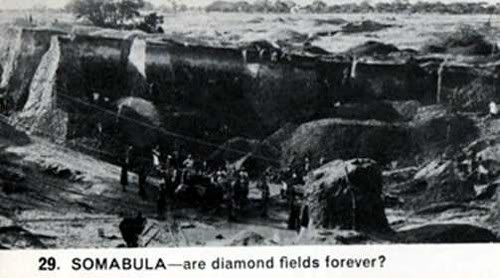
RECENT finds in the Limpopo River have revived the once great hopes that Rhodesia might match South Africa as a major diamond producer. The hunt is on, and only the most hardened cynic today recalls the disappointments of the Somabula diamond fields,
The town leapt into the limelight in 1905 with the discovery of a greenish diamond in a railway cutting just eight miles away. Two years later mining began in earnest Optimism ran high in the town, and one noted expert was inspired to this opinion:
"I have little doubt that it will not be long before the pipe which produced the diamonds is discovered, and that it will present, apart from local peculiarities, all tho usual features of the South African mines already so well known. The discovery foreshadows the development of an important part in the diamond industry of Rhodesia."
The first year was exciting. Diamonds, topaz, sapphires, rubies, aquamarine and chrysoberyl. valued at $40 000 came out of the diggings. Since then annual production has more often been below $200. A fortune has been spent on further investigation but there has been no mining since 1957.
Only the occasional prospector or old-timer potters about the diggings now. The excitement and the lustre have gone.
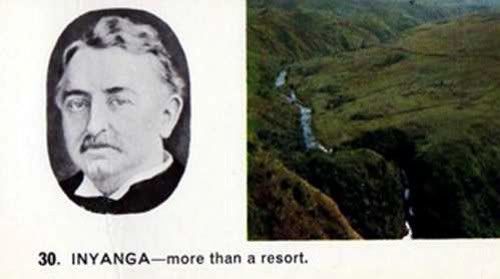
THE Rhodes Inyanga Estate is at the very heart of Rhodesia's Eastern Districts playground. The Mare Dam and Pungwe Falls are just two of the many attractions that bring thousands of tourists to the area each year. It is known as a resort area, but once it was the Inyanga property of Cecil John Rhodes.
An early Rhodesian writer. J. G. McDonald, recalls in his biography of Rhodes that it was he who persuaded the great man to visit the Inyanga district. Enchanted with what he had seen. Rhodes immediately directed McDonald to buy a large tract of land for him there—"and be sure you take in the Pungwe Falls".
The land cost him $100 000 in 1897. and Rhodes soon began to improve upon his investment. From the local stone he built a cottage and stables. Then he started experimental work with stock, cereals, vegetables and fruit trees. When he died, he left the Estste in trust for tho people of Rhodesia.
The cottage is now a part of the Rhodes Hotel and the stables can still be seen there. So too can Rhodes' handiwork, for the beautiful forests of pine and gum and the modern research station follow very much the work he started there.
THE Rhodes Inyanga Estate is at the very heart of Rhodesia's Eastern Districts playground. The Mare Dam and Pungwe Falls are just two of the many attractions that bring thousands of tourists to the area each year. It is known as a resort area, but once it was the Inyanga property of Cecil John Rhodes.
An early Rhodesian writer. J. G. McDonald, recalls in his biography of Rhodes that it was he who persuaded the great man to visit the Inyanga district. Enchanted with what he had seen. Rhodes immediately directed McDonald to buy a large tract of land for him there—"and be sure you take in the Pungwe Falls".
The land cost him $100 000 in 1897. and Rhodes soon began to improve upon his investment. From the local stone he built a cottage and stables. Then he started experimental work with stock, cereals, vegetables and fruit trees. When he died, he left the Estste in trust for tho people of Rhodesia.
The cottage is now a part of the Rhodes Hotel and the stables can still be seen there. So too can Rhodes' handiwork, for the beautiful forests of pine and gum and the modern research station follow very much the work he started there.
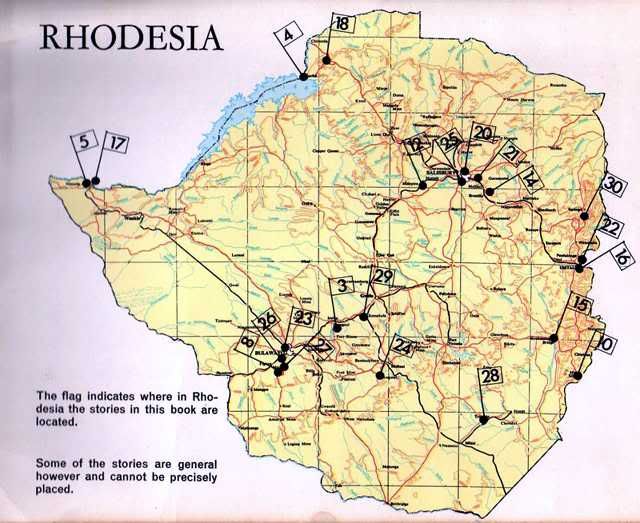
The flag indicates where in Rhodesia the stories in this book are located. Some of the stories are general however and cannot be precisely placed.
End of Article
Recompiled by Eddy Norris, from the Shell Booklet entitled "This Is Rhodesia", for no or intended financial gain but rather to record the events that transpired in Rhodesia
Thanks are recorded to:-
The Publishers and Owners of of this booklet
Darryl Burlin for making the article available to ORAFs.
Paul Mroz for the image hosting sponsorship
Paul Norris for Internet sponsorship
Special thanks to Robb Ellis for his assistance.

ON a bright spring morning in 1927 the people of Umtali heard the piercing note of the post horn for the last time. Four coaches, each drawn by twelve sleek mules, bumped and rattled out of town en route to Bulawayo. They were making Zeederberg's last run after more than thirty years of service in rain and shine throughout Rhodesia
In 1890 Cecil Rhodes commissioned Doel Zeederberg to survey the country and suggest likely road links. Tho work took him three years of hard riding and walking from Fort Tuli and the Limpopo to Fort Victoria. Salisbury and Broken Hill. In 1895 he carried his first passengers and mail from Pietersburg to Salisbury. Soon afterwards the Zeederberg network was complete, with links between all the main towns.
Coaches were imported from Ohio. USA. at a cost of R $700 each. They carried twelve passengers, with room on top for luggage. Mules generally provided the power, but Zeederberg once used a span of trotting oxen. When mules were very scarce he even tried to train zebras, but they proved too slow and lazy.
Motor transport and the railways finally ended the days of coaching, but they had already done sterling service. Rhodes himself said that no other individual had done more to open up Rhodesia than Doel Zeederberg.

A 270-year-old gin bottle, a Chinese bowl and a pair of Arab handcuffs. Prize finds from Dhlo-Dhlo, one of the many ruins of ancient stone buildings throughout Rhodesia, but finds that simply add to the the mystery of the country's past.
Who drank the gin. or perhaps more important, who brought it to Dhlo-Dhlo? All that is known is that the bottle is Dutch and that it dates to around A D 1700 The blue and white Chinese bowl is thought to be from the Ming dynasty, and the handcuffs are definitely of the kind used by Arab slavers. Other interesting finds include a candlestick, two Portuguese cannon and a handful of religious relics.
Dhlo-Dhlo lies a few kilometres from Fort Rixon. and is one of the more interesting ruins. It features five different types of wall decoration. including the famous Zimbabwe chevron pattern.
Some experts believe it may have been the centre of a sun worship cult. They feel certain too. that observations of the sun and stars were taken there.
The building is thought to date from the second Zimbabwe period, but no one knows for sure. The ruins themselves have provided a mixed bag of clues
Perhaps more wait to be uncovered.

ON A calm day Kariba presents a warm and comfortable sight Houses nestle against the hillsides. The lake stretches for miles, still as a millpond. There is little to suggest tho turbulent and sometimes tragic past that made Kariba a much feared name to the people who lived in the valley before the gorge was plugged with concrete.
Perhaps the great river god 'Nyaminyami' has given up his age-old battle against mankind.
Where the mighty Zambezi squeezed through the narrow gap at Kariba. the resulting fearsome turbulence had carried many a man to his death. It was probably this danger that gave rise to the legend of Nyaminyami. At any rate, the locals believed the god existed, and they predicted a diro fate for anyone who attempted to meddle with his domain. They viewed plans to build a wall there as a most provocative piece of interference.
Subsequent deaths by landslide, flood and construction accident confirmed their belief. Nyaminyami' was fighting back
But in the end. the work was completed. Only occasionally now. when a sudden squall from the west whips up huge waves on the lake and boating becomes dangerous, do tribesmen still tremble for fear of Nyaminyami!

IF you stand on the bridge spanning the gorge at the Victoria Falls when the Zambezi is in flood, you will surely feel the spray as the waters thunder down. And if the sensation gives an added thrill to your visit, then you will be helping to satisfy one of the dreams of our founder. Cecil John Rhodes.
Although he did not live to see the bridge, its location was due entirely to his sense of the aesthetic. Cautious engineers had recommended a far easier site six miles above the falls, but Rhodes would have none of it. Instead he insisted that the bridge cross the gorge at a point where train passengers could feel the spray.
His romantic notion greatly taxed the skill of designer and engineer, but the bridge slowly began to take shape. Work was always extremely dangerous because of the 350-ft. sheer drop, but thanks to meticulous safety measures, accidents were kept to an absolute minimum. During the entire operation only one worker was killed.
The final girder was swung into position and tightly bolted down at 6 a m. on April 1st. 1905. A great man's dream of a graceful railway bridge had become reality.

INCURABLE romantics look back wistfully to the days of the old transport rider, conjuring up visions of endless happy trekking through Rhodesia's pleasantly wooded countryside. Little do they really know!
"The Road". as tho old riders know it. took a heavy toll in patience, sanity and even life.
Before the railway arrived, all supplies, from a matchbox to a mill, wore brought in by ox wagon. Roads, as we know them, did not exist. In their place wore rutted tracks linking one centre with another, a series of sandy drifts across the rivers, and by the wayside an occasional trading store cum pub.
One of the riders who wrote most about his life in Rhodesia was Stanley Portal Hyatt. On page after page his books reflect a hard and relatively unrewarding career During the rainy season, progress could more often be measured in inches per day than miles per hour It was nothing to bo held up at a swollen river for six weeks at a time. Lion, hyena, jackal and snakes were a constant menace to his cattle. And in the end, the rinderpest put him out of business.
"The cattle died within a few hours." he wrote "And then the transport rider, utterly broken, utterly helpless. abandoned all and tramped back to the nearest outspan., to curse his luck, to drink so as to forget that luck, and. perhaps, to die."

ACCORDING to African legend the baobab owes its grotesque beauty to an angry god who wrenched it from the ground and in his fury replanted it upside down. Thus its branches are what were once its roots. Certainly that is what it looks like, but grotesque or not. it is one of the most useful trees in the Rhodesian bush
One way or another, the baobab is capable of providing man with shelter, food, water, cloth and even liquor.
The interior, saturated with water, is more pulp than wood, and experienced bush men know well how to tap the precious fluid in times of emergency. The fruit is a source of cream of tartar, and was at one time used as the chief ingredient in a brew against malaria.
The fruit provides an emergency food for man, fodder for cattle and a source of fibre for weaving coarse cloth. The pollen yields a glue, and the flowers can be distilled into a liquor.
Among the more famous of these giants is on tho border where Rhodesia meets the Caprivi Strip. Standing behind a neat little house, the tree has been carved and hollowed out to form a room
Inside is the toilet, complete with water flush!
Though the baobab is found in other African countries, and even in Australia, its great abundance in Rhodesia gives it an undoubtedly special relationship with our land.

THE View of the World was always a sacred spot. Even before the time of tho Matabele, this granite hill in the Matopos was known to tho Karanga people as Malindidzimu. 'the Holes of the Spirits'. The Matabele kept the name and revered the hill. Rhodes saw it and is buried there—as are 36 other Rhodesians who have "deserved well of their country".
The words themselves belong to Rhodes. In his will he asked that "no person be buried there unless the Government says that he or she has deserved well of tho country".
Close by the path that leads to his grave, at the foot of the last rise, is a tablet, carved from solid granite. It records the simple message:
"This ground is consecrated and set aside for ever."
Also at Rhodes's request. the 34 men of Allen Wilson's patrol who were killed at the battle of the Shangani in 1893. are buried there.
Leander Starr Jameson, early Administrator, and Sir Charles Coghlan. first Prime Minister of Southern Rhodesia, have their last resting place at World's View.
The honour has been sparingly given so that this lovely hill will truly be much venerated for generations to come.

NEARLY a hundred years after his death his work is still well known and highly valued. And although he was not. in the strictest sense of the word, a Rhodesia he was an early visitor here. becoming a groat favourite of the then heir to the Matabeleland crown, Lobengula.
Thomas Baines was born at King's Lynn. England, in 1820 As a young boy he was apprenticed to a commercial artist, and at the age of 22 sailed for the Cape.
There he began work as a professional painter, but did not stay long. After many travels, including a voyage to Australia, he returned to Africa and led an expedition to Matabeleland and Mashonaland in search of gold.
It was a time of political instability, for Mzilikazi was dead and Lobengula had not yet been proclaimed king. He quickly became friendly with Lobengula who was fascinated to watch him at work. In his Northern Goldfields Diaries. Baines records: "I cultivated his friendship through the medium of art."
Everywhere he went his paintings acted as his passport and his purse. Africans were intrigued by his colourful sketches of their daily life, and lonely traders often engaged him to decorate their homes or restore the sign-writing to their wagons.
He died of dysentery in Durban on May 8th. 1875, leaving behind a vivid record of the Africa he had known.

ON a far-off corner of Chipinga, on Mount Selinda. close to the Portuguese border, is a magnificent Red Mahogany that may have been a sapling when Caesar ruled the world. Nearly seventy metres tall with a handsome fifteen metre girth at its base, the tree still flowers every year and scatters its winged seeds to the corners of Chirinda Forest.
Tho 500 hectare forest and the mighty tree have been declared National Monuments so that all Rhodesians may enjoy their splendour for many generations to come.
The visitor comes upon the forest quite suddenly. Like a mighty wall it looms tall to tho sky. Mosses and ferns flourish in the dark depths. All is silent and still. Three species of mahogany form the main arboreal population. Many are ancient, but none as old as the Great One.
Each November, its small, delicate white flowers open to the sun. The fruit swells slowly until the following summer a pod bursts and sends forth seed.
Who knows, perhaps some seed now sprouting and taking root will delight our descendants in
A. D 4000?
T0 ANY but tho most dedicated naturalist, the crocodile is a loathsome creature. With sixty savage teeth in a savage looking head, the reptile's appearance alone is enough to strike fear. Add the ability to move silently and invisibly through murky water. and you have a perfect recipe for total enmity.
The fact is that until recently, the crocodile had very much more to fear from man than vice versa, 1n Rhodesian waters.
Crocodylus niloticus was a most successful species until man brought his sophisticated weaponry to bear. Fashion placed a value on tho crocodile's skin, and that was almost enough to guarantee extinction. Hunters wrought havoc among the once large riverbank populations. sometimes killing nearly a hundred in a single night.
Worried naturalists, convinced that the reptile was a vital part in the balance of river life, finally won a protracted battle to bring an end to the systematic slaughter. Now indiscriminate shooting is prohibited. The hunter's rifle and shooting lamp have given way to progressive husbandry And crocodile farmers themselves protect tho future of the species by returning a certain number of young to the rivers of Rhodesia each year.

A PRIZE of thousands of dollars awaits the first person to fly a man-powered machine over a half a mile. figure-of-eight course. Many have tried, few have even got off the ground. A Rhodesian almost accomplished the feat way back in 1921. but there was no prize then, nor was he after money. He simply wanted to survey his farm from the air.
Gino Sacchi came to the country in 1917 and settled at Makwiro, 80 kilometres from Salisbury No ordinary immigrant, he had lived with fame at his fingertips as draughtsman for Bleriot. first man to fly the English Channel.
In 1921 Sacchi designed and built a 'sky-bike', in which he planned to fly around the farm. It was made from bamboo, canvas, steel wire and aluminium at a cost of under $30.00. The pilot sat facing the rear, providing power by pedal, chain and aluminium shaft
At the very first attempt Sacchi actually got the craft aloft and kept it there for several moments. Exhausted, he next asked his faithful servant Masumo to make an attempt. Frantically though he pedalled Masumo only succeeded in crashing headlong into the bush.
There is no record of any further attempt, but Sacchi must still rank almost certainly as the first airman to get off the ground in a man-powered machine. Unfortunately the record cannot be officially claimed because there were no official witnesses!

Tragelaphus angasi is a shy and unforgiving animal. Long experience of the hunter's rifle has taught the Nyala to seek almost permanent refuge in the gloomy depths of riverine forests. Only very occasionally does the "fleeting ghost" emerge at late evening to feed in some open glade. Human eyes seldom light upon its great beauty.
Thus has been born tho belief that the Nyala is facing extinction in Rhodesia. In fact they are nowhere near so, and though few people ever see them, experts report that they have adapted well to living in relative proximity to humans.
The Nyala, like the Kudu, wears distinctive white stripes along its body and a strong white chevron upon its face. It is greyish brown, with a ridge of long white hairs on its back. The long hairs on its neck form a clear mane. Beautiful white spots decorate its flanks and the male Nyala sports a handsome set of curving horns.
Shy as they are. tho Nyala can bo dangerous when cornered or wounded, but far prefers flight to fight. The privileged few who have seen them speak of their extraordinary beauty, and it seems a great pity that the Nyala has found it necessary to treat us with invisibility.
Perhaps, now that he has been protected, 'the fleeting ghost' will gradually emerge from the forests to show himself off to our admiring visitors.

THE cost of making today's modern super highways run into many, many thousands of dollars per kilometre Forty years ago a scheme for surfacing Rhodesian roads was abandoned because it was too highly priced at $800 per mile!
It was the year 1930, and with the rapid advance of the motor car. something had to be done about the rutted, corrugated and dusty roads. As an experiment, two parallel strips of concrete were laid on the road between Gwelo and Selukwe.
"Too expensive", said the pundits as they looked at the $800 per mile bill. Thus the experiment ended for the moment, but it did give birth to the unique strip system that ultimately served the country so well.
The breakthrough came with asphalt. Strips could now be made for $200 loss per mile, and tho saving tipped the scales in favour of a major, countrywide building programme. By the middle of World War II. when tho programme ended, many hundreds of miles of rough dirt road had been converted into what, for the time, were highly acceptable highways.
On January 23rd. 1970. a short stretch of strips near Melfort was declared a national monument so that future visitors might be guaranteed a close-up view of an otherwise vanishing Rhodesian curiosity.

IT IS now nearly 40 years since Birchenough Bridge was opened across tho Sabi River. Before 1934, motor travellers between Fort Victoria and Umtali were faced with a most unusual crossing. Whether they liked the idea or not. they had briefly to exchange their modern horsepower for the power of the humble ox.
Two spans of oxen were stationed at the crossing, a point not far from the bridge site, and on each side of the river a plough disc 'simbi' hung in the shade of a big tree. On arrival, the motorist would summon a team by beating loudly on the makeshift gong. If he was too early the team would not yet have been rounded up. Too late and the oxen would already have been kraaled for the night.
In daylight hours however, a team would appear, fully inspanned and complete with 'tow rope*.
The haul across the river could be made only in the dry season when the actual course was confined to a narrow and shallow channel in the sandy bed. For anyone foolish or unlucky enough to attempt the trip when the Sabi was in flood, the prospect was simply a long, long wait. At such times the oxen enjoyed a well deserved rest!

THOUGH other Rhodesian towns have changed position, none has shifted ground quite as much as Umtali. In the first ten years of its life, first gold, then the attraction of transport, prompted one move after another.
The first place to bear the name was little more than a camp on a rise in the Penhalonga valley. Here a contingent of pioneers and police pitched their tents and built a small fort in November 1890. Less than a year later the site had to be abandoned because enthusiastic prospectors had pegged the entire area, including the fort ! New Umtali came into being some miles away on the Umtali river, and with 300 stands actually surveyed, government buildings and a police camp erected, the stage seemed set for a stable future. By 1896 the population was close to 100. and everyone was looking forward to the arrival of the railway line from Beira. when the real boom would surely begin.
Too bad! Engineers decided the hills were too steep to get the line to Umtali. so they would have to bypass it. Cecil Rhodes stepped in. If the line couldn't get to Umtali. could not Umtali get to the line ?
Against some opposition and with the aid of fair compensation, the majority agreed to move. By September 1897, Umtali had finally come to rest. The beauty of the site never fails to impress the visitor today, and he must surely wonder why it wasn't first choice anyway.

THE Victoria Falls defy adequate description. Words alone can never capture their great beauty and almost frightening power. Every man must see them for himself.
The trip is well worth the effort, as Major Henry Stabb found in 1875 when he walked all the way from Bulawayo! He was not the first to visit tho Falls, but he certainly was among the initial handful of 'tourists', and he left a vivid account of his journey.
Major Stabb was stationed with tho British army at Queenstown in South Africa when he decided to go to the Zambezi. Travelling to Lobengula's capital at Bulawayo by ox wagon, he had to continue into the tsetse fly country on foot. The march took nearly a month. He suffered terrible boils and blistered feet, at times he was without food or water, yet when he reached the Falls he was overwhelmed by what he saw.
"They are wonderful, beautiful and grand beyond description." he wrote in his diary that night. "The impression left by the magnificence of the panorama can never be effaced. Once beheld it must forever be a cause of wonder, even to the least impressionable man..."

PEOPLE who have visited Kariba fairly regularly over the past fifteen years often comment how much they miss those tell-tale signs that once marked the road from Mkuti. Buffalo Nek', Puff Adder Ridge'. Savory's Folly'; names to capture the excitement of Rhodesia in the days when the mighty dam was being built.
There was a certain panache about the way things were done then. The road to the gorge had to be completed in six months before the heavy rains of 1955 brought everything to a standstill.
With the route not yet even surveyed, experts judged the target impossible Not so the Irrigation Department's Mr. J. Savory. A part-time hunter. Savory knew of an elephant path from the main road to the vicinity of the gorge, and he also knew that where the heavy elephant trod, man could confidently follow.
And so the Department's young engineers worked in the footprints of the herds, marking their progress with the memory of various incidents: here someone stood on a puff adder, there they had a brush with truculent buffalo. And at Savory's Folly' the work almost came to a standstill in a difficult two-mile patch
Now the road is tarred and the signs are gone, but the memory remains—and the elephant still walk that way.

HE'S just a tiny little chap. Scientists call him Indicator indicator. In the late African afternoon you may meet him as you stroll through the bush.
"Cher... Cher. Che. cher..." he shouts at you and flaps his wings noisily as he darts about to attract your attention. Watch him. Follow him. for he will lead you to a bee hive. And if you should rob it, take care to leave a little honey for your guide. If you fail him, it is just possible ho will take a nasty revenge—or so African legend has it.
Tales of the Honey Guide's achievements abound in this country. Most of them have the usual happy ending in a honey comb, but some are more sinister. There have been persistent claims, for example, that the bird lures strangers to an angry lion's den or into the path of a charging elephant.
The evidence is purely circumstantial, and ornithologists agree that while Indicator indicator may occasionally have slipped up and led the unsuspecting to a nasty end. his motives are strictly honest. Its honey he's after, and without you or a friendly badger, he can't get it!

AS YOU flash by the National Archives on the Borrowdale road a few miles from Salisbury, the sharp white walls and a black funnel-like structure give the appearance of a mighty ocean liner tied fast to the quayside. Within, however, the busy men and women padding along the silent corridors are accommodating history instead of passengers.
Want to know who named Mount Hampden? What route Father Silbeira followed to Angola in the sixteenth century?
The answers are close to hand at the Archives. Newspapers, pamphlets. letters, books, paintings company records—whatever is produced in Rhodesia or about Rhodesia each day finds its way here, where the country's history is on file.
Early records of Rhodesia were kept by the BSA Company, but only those that were thought worthwhile at the time. Some were sent to London, others destroyed. Then in 1935 the Archives Act was promulgated. A call went to London for the return of documents held there, but war intervened, and many were destroyed by German bombs in an air-raid.
The Archives soon outgrew its first tiny offices. The present building was commissioned in 1961, and now houses a truly fantastic collection from which the researcher can gleam detailed information on almost any aspect of Rhodesian life and history.

THERE is nothing quite like the Rhodesian State Lottery In thirty-seven years it has become firmly established as part of the Rhodesian way of life
Millions of dollars have been paid out in prizes; millions have gone to charities and other public orientated projects. And although the sweep is now held every month, the excitement of a big draw never fades.
Jackie Keller. Trade Unionist and MP. had to fight hard to have the lottery officially recognised. The idea first came up in 1929. when the railwaymen he represented were particularly hard hit by the depressions In an attempt to raise funds for the most needy cases, he ran the 'Unity Stakes'. This unofficial lottery was a groat success, benefiting many charities and individuals at a time when there was very little public money for relief work. But the law was unimpressed, and Keller was taken to court and fined $100.
Refusing to give up. he took the matter to Parliament, determined that the lottery should be put on an official, state basis. Clearly he had captured the public imagination, so in 1934 a referendum was held and Keller's lottery lobby won by the handsome margin of 16 946 votes to 3 604
The official wheels of fortune had their first spin on December 20th. 1935
To view a lottery ticket please visit the link below:-
http://rhodesianheritage.blogspot.com/2010/10/rhodesian-state-lottery-ticket.html

UNTIL quite recently a corner of Umtali's Main Street was scarred in the centre where two old rail lines showed through the tarmac—relics of the town's long-forgotten tramcar public transport. As the only centre in Rhodesia to have boasted a tram service. Umtali has little to regret and much fun to look back on.
Old timers still smile at the recollection of tho creaky old carriages battling up Main Street behind a span of oxen or mules
The Tramway Company was actually registered in 1897. but it was not until 1901 that the first passenger took his maiden trip at the princely sum of five cents a mile. The service was not a groat commercial success, and the advent of the motor car spelled eventual disaster Its total life span was under 20 years, but death came slowly, provoked by constant complaints from motorists that the Main Street lines interfered with their slender tyres.
Towards the end the service was being run only once a month, and each occasion was celebrated afterwards with a splendid party
Now. a few wheels, a brass handle and a bell lie stranded for our inquisitive eyes upon a shelf in the Umtali Museum; tho last lonely reminders of the city's brief flirtation with the tram.

ALTHOUGH his name was later to become associated with another, far more famous make of automobile, Charles Duly chose a French 6½ horsepower 'Gladiator' as the first car to be brought into Rhodesia. The year was 1902; the city Bulawayo.
Doubtless many Rhodesians had seen motor cars in their travels elsewhere, but the arrival of the Gladator caused something of a stir in Bulawayo. There is no record of Mr. Duly having to copy the English practice of having a man walking in front of his machine with a red flag, but the wonder and apprehension which the motor car caused are nevertheless quite clear. Assigned to report on the wonderful machine, a Bulawayo journalist recorded in obvious awe that the chain-driven, single cylinder contraption was powered by "a spirit called petrol". It was steered, he added, by a "wheel which enabled the driver to change direction at any speed". thus avoiding tho stones and tree stumps which were the main feature of Rhodesian roads.
Whatever the reception, the car had come to stay. However. Charles Duly made his mark on the country for more than importing the first car. During the First World War he organized and commanded Rhodesia's first military motorised transport division, which saw service in Tanganyika. For his part. Duly received a special letter of commendation from Winston Churchill.

SPODUMENE. hiddenite. carnelian and jade. Spinel, chalcedony, zircon and epidote .. . gemstones of Rhodesia's wonderful natural collection. With close to a hundred different types—from diamonds to common quartz—Rhodesia is certainly gemstone country.
Despite the comparative abundance, the collection of gemstones in this country was left to only a few enthusiastic collectors until relatively recently. Now their ranks have swelled considerably, and backroom workshops where stones are cut and polished have turned a hobby into an industry,
The stones owe their value to their hardness, rarity and beauty—a quality that may involve colour, lustre, clarity or sparkle Finding the stones is. of course, not easy, but there are places in the country where geologists say finds are most likely. Karoi and Unrungwo produce sodalite. cordierite. beryl, topaz and tourmaline. The area around Fort Victoria yields beryl, chrysoberyl and spodumene. Superb emeralds come from Belingwe, and diamonds have been found in different parts of the country.
Aside from the truly precious stones, such as diamonds and emeralds. collectors often cut, polish and tumble their own specimens, exporting the best examples. Better stones like the Belingwe emeralds are used in the most exquisite jewellery.

SINCE 1966. tobacco auctions have been held each year behind closed doors. Gone, for the time being at least, is their glory and glamour as one of Rhodesia's major tourist attractions. After many, many years in the public limeligh. it seems incredible that Salisbury children now growing up have never heard the magic of tho auctioneer's chant.
Visually, the sales might have been confusing to the newcomer. Hundreds of bales of tobacco were set out in long rows across the vast floor. Little knots of people could be seen dotted about, touching, feeling, smelling tobacco from the opened bales Somewhere among the rows a buying team would be moving at a steady clip from bale to bale, apparently to the accompaniment of an unintelligible song.
"And a hibbedy hibbedy hub. and a hibbedy ha. and a ha. and a ha. and a ha ha ha ..the auctioneer seemed to sing, while the buyers behind him would lift a finger, touch an ear or nod to signify their acceptance of the escalating price.
Once, when a royal visitor expressed surprise that the human throat could utter such a sound, the Chairman of Tobacco Auctions, who was acting as her escort. whispered: "We make 'em sing to save their voices. Ma'am. That's why we have to feed 'em on bird seed!"

SIXTEEN miles from Bulawayo on the Old Gwanda road the traveller will come upon a great Imgugutu tree. In its shade by the road-side stands a huge slab of granite surrounded by a low and attractive stone wall. Today it is just a monument, a spot on the veld. Busy, exciting Mhlahlandlela has gone for ever: gone with the death of the king who made it.
Mhlahlandlela. Capital, for the last years of his reign, of Mzilikazi. founder of the Matabele nation
To his people ho was little less than a god For nearly half a century the Lion of the North' ruled absolutely. On a single command, whole villages might be put to the torch by his impis Yet it is said that he ruled wisely and well. Like his son Lobengula. he was a great friend to the white man. Hunters and traders were frequent and welcome guests at bustling Mhlahlandlela.
When he died. Mhlahlandlela went into mourning and ultimately ceased to exist, for Lobengula moved the capital to Bulawayo.
His fathers' monument was erected in 1941 by the Bulawayo Rotary Club—paid for entirely by European subscription.
The inscription reads simply:
''Mzilikazi. son of Shobana. the Matabele hail you. The Mountain fell down on September 9th, 1868. All nations acclaim the son of Shobana. Bayete!"

TWELVE miles beyond the Matopos Mission on the Old Gwanda Road is a wonderful cave of ancient human habitation. A preserved National Monument, Gulubahwe is nearly ten metres wide at the mouth and five metres from the floor to roof. It contains some of the best preserved and most unusual rock paintings in Rhodesia.
Chief among the paintings is one that has puzzled many archaeologists. It stretches for half the length of the cave and is a fabulous monster of primitive imagination. The five-metre long snake has awesome teeth, ears and a curly tail. From its nostrils appears a faint suggestion of smoke.
Unlike many rock paintings it is extremely colourful. The head and tail are in red. the body a faded white. The underside is yellow, outlined in purple.
Strangest of all the monster's features are twenty-four undulations along its back. On these are depicted fourteen human figures, seven baboons, three buck, and a baboon with the head of a buck.
Gulubahwe was discovered by Europeans in 1904. African porters with the party announced that they knew the beast well. Yes. they said, it was a snake. But it was a snake made of hills and rivers, and men lived upon its back.

GIVEN water, man can make the desert bloom. Without it, the richest soil is wasted, as was the case for many years with Rhodesia's fertile southern lowveld. The vast agricultural development that has taken place there in the past fifteen years stems largely from the efforts of one man. Tom Macdougall brought water to his fields in 1931 and proved that the lowveld could flourish.
Macdougall first saw the area in 1912, but it was only after the First World War that he bought land there and began ranching cattle on Triangle Estate. A serious slump in 1922 turned his thoughts to diversification, and having worked on a sugar estate in British Guiana, it was natural he should think of this crop. But he needed water, and a range of granite hills stood between his fields and the nearest reliable source, the Mtilikwe river. The obstacle was difficult, but not impossible, so for the next seven years, working when funds permitted. Macdougall blasted a tunnel through nearly 500 metres of solid granite. Finally tho work was complete. Water flowed to his lands and the sugar cane grew well. A new industry was born.
Today the tunnel and his first canals are overgrown. More modern waterworks have replaced them. But Lake Macdougall in the lowveld commemorates the powerful contribution of a very dogged Scot!

RECENT finds in the Limpopo River have revived the once great hopes that Rhodesia might match South Africa as a major diamond producer. The hunt is on, and only the most hardened cynic today recalls the disappointments of the Somabula diamond fields,
The town leapt into the limelight in 1905 with the discovery of a greenish diamond in a railway cutting just eight miles away. Two years later mining began in earnest Optimism ran high in the town, and one noted expert was inspired to this opinion:
"I have little doubt that it will not be long before the pipe which produced the diamonds is discovered, and that it will present, apart from local peculiarities, all tho usual features of the South African mines already so well known. The discovery foreshadows the development of an important part in the diamond industry of Rhodesia."
The first year was exciting. Diamonds, topaz, sapphires, rubies, aquamarine and chrysoberyl. valued at $40 000 came out of the diggings. Since then annual production has more often been below $200. A fortune has been spent on further investigation but there has been no mining since 1957.
Only the occasional prospector or old-timer potters about the diggings now. The excitement and the lustre have gone.

THE Rhodes Inyanga Estate is at the very heart of Rhodesia's Eastern Districts playground. The Mare Dam and Pungwe Falls are just two of the many attractions that bring thousands of tourists to the area each year. It is known as a resort area, but once it was the Inyanga property of Cecil John Rhodes.
An early Rhodesian writer. J. G. McDonald, recalls in his biography of Rhodes that it was he who persuaded the great man to visit the Inyanga district. Enchanted with what he had seen. Rhodes immediately directed McDonald to buy a large tract of land for him there—"and be sure you take in the Pungwe Falls".
The land cost him $100 000 in 1897. and Rhodes soon began to improve upon his investment. From the local stone he built a cottage and stables. Then he started experimental work with stock, cereals, vegetables and fruit trees. When he died, he left the Estste in trust for tho people of Rhodesia.
The cottage is now a part of the Rhodes Hotel and the stables can still be seen there. So too can Rhodes' handiwork, for the beautiful forests of pine and gum and the modern research station follow very much the work he started there.
THE Rhodes Inyanga Estate is at the very heart of Rhodesia's Eastern Districts playground. The Mare Dam and Pungwe Falls are just two of the many attractions that bring thousands of tourists to the area each year. It is known as a resort area, but once it was the Inyanga property of Cecil John Rhodes.
An early Rhodesian writer. J. G. McDonald, recalls in his biography of Rhodes that it was he who persuaded the great man to visit the Inyanga district. Enchanted with what he had seen. Rhodes immediately directed McDonald to buy a large tract of land for him there—"and be sure you take in the Pungwe Falls".
The land cost him $100 000 in 1897. and Rhodes soon began to improve upon his investment. From the local stone he built a cottage and stables. Then he started experimental work with stock, cereals, vegetables and fruit trees. When he died, he left the Estste in trust for tho people of Rhodesia.
The cottage is now a part of the Rhodes Hotel and the stables can still be seen there. So too can Rhodes' handiwork, for the beautiful forests of pine and gum and the modern research station follow very much the work he started there.

The flag indicates where in Rhodesia the stories in this book are located. Some of the stories are general however and cannot be precisely placed.
End of Article
Recompiled by Eddy Norris, from the Shell Booklet entitled "This Is Rhodesia", for no or intended financial gain but rather to record the events that transpired in Rhodesia
Thanks are recorded to:-
The Publishers and Owners of of this booklet
Darryl Burlin for making the article available to ORAFs.
Paul Mroz for the image hosting sponsorship
Paul Norris for Internet sponsorship
Special thanks to Robb Ellis for his assistance.


7 Comments:
Rhodesians never die - - they just fade away. Thanks to Eddy, and ORAFs, the memory lingers.
Thank you.
Prop Geldenhuys, Durban
Thank you for your post. I am actually looking for an event I was told was sponsored by the State lottery many years ago it has to do with a child being severely burned at Wankie while playing on the coal slag dumps. Where would one go to find any information on events sponsored by the State Lottery. Regards Myrna
Rhodesia was great
This was a "sticker" book. The "stickers" were actually quite stiff cards with ineffective glue on the back that you wet and stuck in the blank spaces in the book, alongside the text. They forever came loose! You collected the cards when you filled up with Shell. They were fairly generous though, I was once given the full set in one go. I can remember these vividly and fondly. Thanks for posting!
Touring this country in 1973 my brother and I played endless 'memory' games in the car with these cards from petrol stations. Thanks for the memories. I still remember the wonderful captions.
I really enjoyed reading this article, and found it quite informative. And especially the part about the popularity of the heritage brass. Thanks for sharing! I generally prefer heritage brass to heritage brass and would recommend it to all.
Greatest country - bar 1.
Post a Comment
Subscribe to Post Comments [Atom]
<< Home